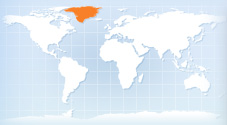Melting Glaciers Threaten to Raise Global Sea Levels by 6 or 7 Meters

Greenland, the world’s largest island, is almost entirely covered by a massive ice sheet that is roughly the size of Mexico (700,000 square miles), is up to two miles thick, and contains nearly a tenth of the world’s fresh water supply. If this ice sheet were to melt completely, sea levels would rise by over 20 feet. Even a 3-foot increase in sea levels would threaten some 70 million people living in coastal zones around the world.
Greenland ice sheet: Slip sliding away?
The rapid changes seen in Greenland over the last decade suggest we are dangerously close to a climatic tipping point. During a visit to Dr. Konrad Steffen’s research station on the Greenland ice sheet, Select Committee members learned about the mounting scientific evidence which makes clear that global warming is causing an alarming acceleration in the rate of melting of the Greenland ice sheet. Average temperatures in southern Greenland have increased by over 4 degrees Fahrenheit in the past two decades, and the area of Greenland’s ice sheet that melts each summer has increased by 16 percent from 1979 to 2002. During the record-setting melting in 2005, satellites recorded melting in areas that have never melted in the past 27 years.
- To see Dr. Konrad Steffen's presentation on the Greenland Ice Sheet click here.
This surface melting further threatens the ice sheet by causing lakes to form on the ice sheet’s surface. The meltwater then percolates downwards through massive cracks in the ice sheet called “moulins,” lubricating the base of the ice sheet and hastening the slide of glaciers towards the sea. As a result, several of Greenland’s largest glaciers are now flowing towards the sea at nearly 8 miles per year, twice as fast as they did just 5 years ago.
The Greenland ice sheet now dumps nearly three times as much ice into the sea as it did 10 years ago—enough every 2 to 3 days during the melting season to supply New York City with fresh water for an entire year. The amount of ice flowing into the sea from Greenland’s ice cap now appears to be outpacing the buildup of snow further inland. Scientists have also observed an alarming increase in “ice quakes” due to glacial movement—measuring up to 5.0 on the Richter scale—raising questions about the ice sheet’s stability. These trends indicate that the accelerating melting of Greenland’s ice sheet increases the risk of dangerous sea-level rise sooner than previously predicted.
On a local scale, global warming is already having negative impacts on the livelihoods of Greenland’s indigenous Inuit population of roughly 45,000. The loss of stable, year-round sea ice is disrupting traditional seal-hunting and fishing practices on which Inuit livelihoods depend. And, as elsewhere in the Arctic, melting of permafrost is causing extensive damage to homes and other infrastructure in Inuit villages. During the Select Committee’s trip to Greenland, the Greenland Premier Hans Enoksen, national and local leaders, and residents all emphasized that changes to their environment are rapid and far reaching economic and cultural impacts.



